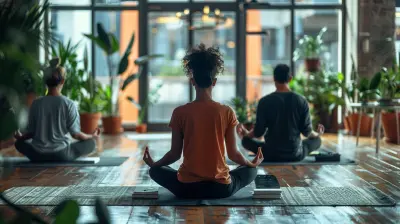6 April 2025
Stress is an unavoidable part of life. Whether it's work, relationships, or unexpected challenges, we all face moments of overwhelming tension. But what if I told you that the key to reducing stress lies in something as simple as breathing? Yep, that's right—your breath holds incredible power, and pranayama, the ancient art of breath control, can be a real game-changer.
In this article, we'll dive deep into the world of pranayama, exploring powerful techniques that can help you calm your mind, reduce anxiety, and regain control over your emotions. Ready to breathe your stress away? Let's get started!
What is Pranayama?
Pranayama, a Sanskrit word, combines "prana" (life force or vital energy) and "ayama" (extension or control). Essentially, it refers to the practice of controlling the breath to influence the mind and body positively.For centuries, yogis have used pranayama to balance their energy and achieve mental clarity. Today, science is also backing up these ancient breathing techniques, proving their effectiveness in reducing stress, enhancing focus, and even improving physical health.
How Does Pranayama Help with Stress Relief?
Think about what happens when you’re stressed—your heart races, your muscles tense up, and your breath becomes shallow. This signals your body’s fight-or-flight response, making you feel even more anxious.Pranayama helps by activating the parasympathetic nervous system, which counters stress by promoting relaxation. When you control your breath, you send a message to your brain that it's okay to relax, reducing cortisol (the stress hormone) and bringing a sense of calmness.
Sounds like magic, right? Well, it's just the power of your own breath.
5 Powerful Pranayama Techniques for Stress Relief
Now that we understand the impact of pranayama, let’s explore some breathing techniques that can help you melt away stress.1. Nadi Shodhana (Alternate Nostril Breathing)
This technique, often called "channel purification", balances both hemispheres of the brain and brings mental clarity.How to Do It:
1. Sit comfortably with your spine straight.2. Use your right thumb to close your right nostril.
3. Inhale deeply through the left nostril.
4. Close your left nostril with your ring finger and release the right nostril.
5. Exhale slowly through the right nostril.
6. Inhale through the right nostril, then switch and exhale through the left.
This completes one cycle. Repeat for 5-10 minutes.
Why It Works:
This technique balances the body’s energy channels, reduces stress, and enhances focus.2. Bhramari (Bee Breath)
Ever heard the calming buzz of a bee? This technique mimics that soothing vibration, instantly easing stress.How to Do It:
1. Sit in a relaxed position with your eyes closed.2. Place your thumbs on your ears and fingers on your forehead.
3. Take a deep breath in through your nose.
4. As you exhale, make a soft humming sound like a bee.
5. Feel the vibrations spread throughout your body.
Repeat this for 5-7 rounds.
Why It Works:
The vibrations activate the vagus nerve, slowing down the heart rate and promoting relaxation.3. Ujjayi (Victorious Breath/Ocean Breath)
Also known as the "ocean breath" because of its soft, wave-like sound, this technique is often used in yoga to ground the mind.How to Do It:
1. Inhale deeply through your nose while slightly constricting your throat.2. Exhale slowly while maintaining the constriction, producing a subtle ocean-like sound.
3. Keep your breath smooth and controlled.
Practice for 5-10 minutes.
Why It Works:
Ujjayi breath increases oxygen flow, slows the heart rate, and calms the nervous system.4. Sheetali (Cooling Breath)
Feeling overheated, both physically and mentally? This cooling breath will help you chill out—literally.How to Do It:
1. Sit comfortably and stick out your tongue, curling the sides.2. Inhale deeply through your curled tongue.
3. Close your mouth and exhale slowly through your nose.
Repeat for 5 minutes.
Why It Works:
Sheetali breath has an immediate cooling effect on the body and helps lower stress levels.5. Kapalabhati (Skull-Shining Breath)
Think of this as the espresso shot of pranayama—it energizes you while clearing mental fog and stress.How to Do It:
1. Sit with a straight spine and take a deep inhale.2. Exhale forcefully through the nose while pulling your navel inward.
3. Let the inhale happen passively.
4. Repeat this rapid breathing cycle for 20-30 rounds.
Why It Works:
Kapalabhati removes toxins, improves lung capacity, and instantly refreshes the mind.
When & How Often Should You Practice Pranayama?
The beauty of pranayama is that you can do it anytime, anywhere. However, for best results:- Morning: Helps start your day on a calm and focused note.
- Before Bed: Relaxes your nervous system for better sleep.
- During Stressful Moments: A quick session can help reset your mind.
Even just 5-10 minutes a day can make a noticeable difference in your stress levels.
Additional Tips to Enhance Your Practice
Pranayama is powerful on its own, but combining it with a few simple habits can amplify its benefits:- Practice in a Quiet Space: Minimize distractions to fully absorb the practice.
- Sit Comfortably: A straight spine ensures smooth airflow.
- Breathe Through Your Nose: This optimizes oxygen intake and filters impurities.
- Stay Consistent: Daily practice, even for a few minutes, brings long-term benefits.
- Pair it with Meditation: Combining pranayama and meditation can supercharge your relaxation.
The Mind-Body Connection: Why Breath Matters
Your breath is more than just oxygen—it’s a direct reflection of your mental and emotional state. Ever noticed how your breath becomes shallow when you’re anxious? Or how you sigh when relieved?By mastering pranayama, you gain a superpower: the ability to control your emotions through breath. Instead of letting stress take over, you can reset your mind anytime, anywhere.
Breath is life, and when you learn to control it, you unlock a new way of living—calm, centered, and stress-free.
So the next time stress hits, just pause, take a deep breath, and remember: Peace is just a breath away. 🌬️
Final Thoughts
Pranayama isn't just some ancient yogic ritual—it's a scientifically backed tool that can help you navigate life's stresses with ease. Whether you're dealing with work pressure, personal struggles, or just need a moment of calm, these breathing techniques can help.Now, it’s your turn to try! Pick a technique, take a few deep breaths, and feel the difference. Because sometimes, the best way to handle stress is as simple as inhaling deeply and exhaling slowly.







Lena Underwood
Unlock the hidden potential of your breath—could these ancient techniques be the key to mastering not just stress, but life itself?
April 15, 2025 at 2:28 AM